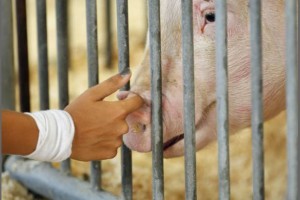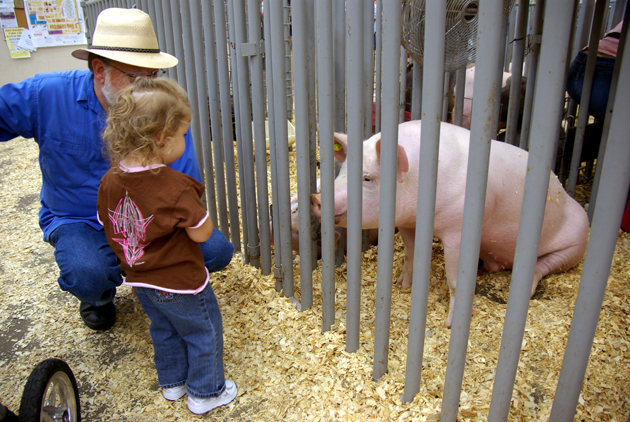This is part of the reason people – and fair organizers – have to be far more careful than they ever thought.
More than 80 percent of pigs that tested positive for influenza A virus at Ohio county fairs between 2009 and 2011 showed no signs of illness, according to a new study.
Ohio State University researchers tested 20 pigs each at 53 fair events  over those three summers and found at least one flu-positive pig at 12 fairs – almost a quarter of fairs tested.
over those three summers and found at least one flu-positive pig at 12 fairs – almost a quarter of fairs tested.
The influenza strains identified in pigs in this study include H1N2 and H3N2 viruses – strains that have been circulating in pigs since 1998. In 2011, all of the H3N2 and H1N2 isolates found in pigs at the fairs contained a gene from the 2009 pandemic strain of H1N1, which is similar to the H3N2v strain causing human illness this year.
Though this finding alone is no cause for panic, it does show how quickly influenza viruses can change, said Andrew Bowman, lead author of the study and a Ph.D. candidate in veterinary preventive medicine at Ohio State.
In a second study led by Bowman, researchers compared the genomic sequences of influenza A viruses recovered in July 2012 from pigs and people. The analysis, showing a greater than 99 percent genetic similarity among the viruses, confirms that pigs and humans were infected with the same virus, indicating interspecies transmission.
As of Sept. 25 this year, the Centers for Disease Control and Prevention (CDC) had confirmed 107 human cases of H3N2v influenza in Ohio since July 2012, with the majority linked to exposure to pigs at agricultural fairs. While most of the human illness caused by H3N2v has been mild, one person, who had a compromised immune system, has died.
Both studies appear online and are scheduled for later print publication. The three-year surveillance at Ohio fairs is published in the journal Emerging Infectious Diseases, and the analysis of human and pig viruses appears in Emerging Microbes & Infections.

 avoid eating around animals as they attend county and state fairs.
avoid eating around animals as they attend county and state fairs..jpg) Reingold says you’re more likely to get sick from influenza, especially the H1N1 virus, from airborne particles because inhaling the flu particles gives you a larger dose than by touching a contaminated object. And, according to Nicas, students at UC Berkeley touch their face an average of 16 times per hour. That is 384 times to transmit what ever is on your hands into mucus glands located in your mouth, eyes, and nose in one day.
Reingold says you’re more likely to get sick from influenza, especially the H1N1 virus, from airborne particles because inhaling the flu particles gives you a larger dose than by touching a contaminated object. And, according to Nicas, students at UC Berkeley touch their face an average of 16 times per hour. That is 384 times to transmit what ever is on your hands into mucus glands located in your mouth, eyes, and nose in one day. Seasonal influenza
Seasonal influenza
 The story says:
The story says:.jpg)